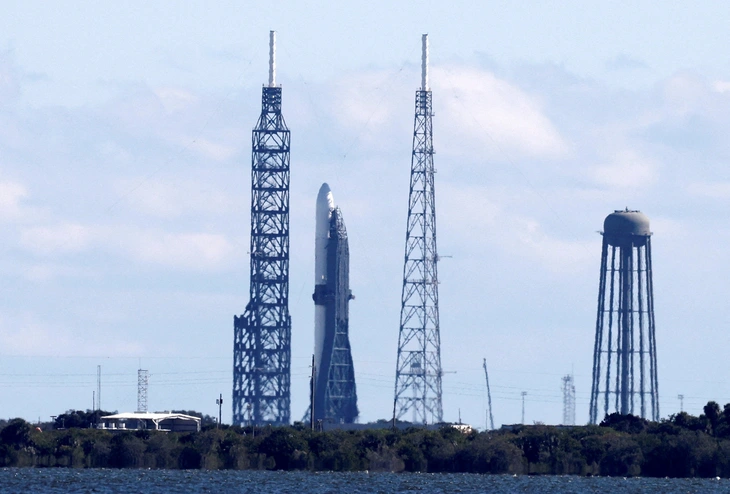
The New Glenn spacecraft carrying two satellites to Mars orbit rests after a second delay at the Cap Canaveral Space Force Station, Florida, US on November 12 - Photo: REUTERS
Blue Origin said its New Glenn rocket is ready for a new launch to Mars. This will be the first large-scale scientific mission that Blue Origin - the company of billionaire Jeff Bezos - carries out for the US National Aeronautics and Space Administration (NASA), and also the company's first launch since its debut flight in January 2025.
However, Blue Origin announced on its website on November 12 that due to increased solar activity and the risk of affecting the EscaPADE spacecraft (a Mars mission consisting of two spacecraft called Blue and Gold), NASA decided to postpone the launch until space weather conditions improve.
According to plan, New Glenn will be launched on November 10 from Cape Canaveral base (Florida state, southeastern US), carrying two EscaPADE satellites towards Mars.
However, the first launch was canceled due to thick clouds, and the relaunch scheduled for November 12 was postponed indefinitely after the US Space Weather Prediction Center issued a severe magnetic storm (solar storm) warning.
The cause is coronal mass ejections (significant releases of magnetic field and accompanying plasma mass from the Sun's corona) on the Sun that send large amounts of high-energy charged particles into space.
This plasma radiation stream was measured on Earth at level G-4 - “severe”, just below the highest level G-5 - “extreme”, and was forecast to last into the next day.
According to Reuters news agency, magnetic storms can disrupt radio and satellite communications, and increase atmospheric density, causing satellites in low orbit to suffer great friction.
A similar situation occurred in February 2022, when 40 SpaceX Starlink satellites were disabled immediately after launch due to a magnetic storm.
In addition, charged particles from the Sun can also pass through the Earth's protective magnetic field and collide strongly with atmospheric molecules, creating brilliant auroras at the poles. On the night of November 12, the blue and pink lights of the Northern Lights were recorded in many large areas in the US, as far as Texas, Florida and Alabama - a rare phenomenon at low latitudes.
Unfortunately, the two EscaPADE satellites are the very instruments that study similar phenomena on Mars.
The two satellites, nicknamed Blue and Gold, will orbit Mars together to analyze how energetic particles from the solar wind interact with the Red Planet's weak magnetic field, and how this phenomenon has caused Mars to gradually lose its atmosphere over billions of years.
EscaPADE is expected to reach Mars after 22 months of travel - when space conditions allow the launch to be carried out safely.
Source: https://tuoitre.vn/bao-tu-cuc-manh-khien-bau-troi-phat-sang-nasa-phai-dung-phong-ve-tinh-sao-hoa-20251113103117466.htm



![[Photo] Unique art of painting Tuong masks](https://vphoto.vietnam.vn/thumb/1200x675/vietnam/resource/IMAGE/2025/11/14/1763094089301_ndo_br_1-jpg.webp)
![[Photo] Special class in Tra Linh](https://vphoto.vietnam.vn/thumb/1200x675/vietnam/resource/IMAGE/2025/11/14/1763078485441_ndo_br_lop-hoc-7-jpg.webp)


![[Photo] Unique architecture of the deepest metro station in France](https://vphoto.vietnam.vn/thumb/1200x675/vietnam/resource/IMAGE/2025/11/14/1763107592365_ga-sau-nhat-nuoc-phap-duy-1-6403-jpg.webp)







































































































Comment (0)